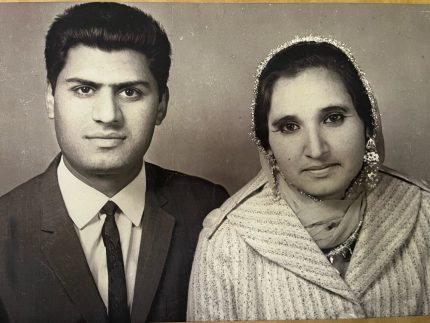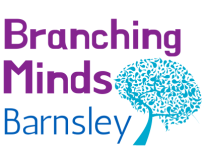“In my experience, people thrive when all of who they are is acknowledged.” – Manreesh’s South Asian Heritage Month story
Hello, my name is Manreesh. Working as part of the adult and older people’s mental health care group, I help older people with the problems they have been through so they can enjoy healthy relationships in their day to day lives.
I’m so glad that the Trust is celebrating South Asian History Month.
This awareness month gives us a positive way to highlight and celebrate the differences and similarities between communities in South Asia, rather than making assumptions about communities. In my experience, people thrive when all of who they are is acknowledged by another person, organisation or group.
I’ve enjoyed reading the staff stories featured on social media, the intranet and the Trust website. It was also great to hear Nash and Katie’s podcast too. I’m sharing my personal story to help other colleagues feel proud of the history and future of people from South Asia.
As a consultant clinical psychologist, I am used to a professional culture bound by strict privacy and confidentiality rules. This can make it hard to ‘open up’ to others. However, in the right setting and at the right time, it can have a hugely positive impact on a person’s mental health, which helps them in every aspect of their life.
This is who I am: I’m proudly Yorkshire, born and bred in Huddersfield. I am also a 1st generation British Asian. Me and my extended family experience common challenges that relate to our past but our story is also one of resilience, creativity and beauty. Let me explain more.

My parents migrated from the Punjab region of northern India during the 1960s.
My dad was invited to work here by the British Government, to help fill gaps in the job market. This still happens today although the international employment invites are handled more sensitively, to try and avoid the upset caused amongst the Windrush generation. Many of these people and their children/grandchildren feel exploited by the way that the British Government treated them after they entered the UK, and these feelings are still very relevant today.
My parents recall seeing public signs everywhere, which blocked their entry to shops/cafes/some parks and other public spaces. It makes me shudder when I think of the distress caused by the wording of this sign: “No Black, no Indians, no dogs.”
My parents are resilient and sought out people from South Asia to help them create a life, family and safe community here.
My dad arrived in the country, with his best friend, £3 in his pocket and a steely determination to work, so that he could send money home to his family in northern India. They originally were going to come to the UK for a few months and see how things worked out. Thanks to his solid work ethic, he created a life for himself and his family here, working hard in factories and eventually working on the buses.
My parents got married in India in 1969 and settled in the UK. They set up a corner shop together whilst my dad continued working on the buses and my mum managed life at home. Life was busy.
After they closed the shop, my mum started work as an interpreter in the NHS. She supported new mums at ante-natal clinics to get health support. She worked in the NHS until retirement age.
Me and my sisters were so lucky that our mum and dad worked so hard to encourage us to speak in Punjabi, so that we all became fluent in the language. Being bilingual is such a gift: it helps us to talk to older friends and family, helping everyone to feel connected. I think it can be harder for some next generation British Asians to learn the language, feeling the pressure to speak English because they want to fit in at school and with their friends, but missing out on the chance to practice other languages.
I am the youngest of 3 sisters. We enjoyed home cooked Punjabi food together daily. When I think of home, I think of the warmth of a Sunday lunchtime favourite: paranthe stuffed with aloo (potatoes). Eating it now transports me back to the warm embrace of my early family life.
Me and my sisters experienced the incredible impact and value of being loved; food was just one expression of my parents’ love for us. Our parents worked hard to navigate and embrace both cultures that we found ourselves in.
Like many 1st generation British Asians, I’ve faced the pressure to minimise my differences to others around me, so as to conform to British ‘norms’ and fit in. It is hard to be an outsider in any situation.
However, I firmly believe that people “can’t be what they can’t see.” I am committed to promoting equality and inclusion in my professional life, so that I can be a role model to others who are making career decisions. We need people from all backgrounds to care for the people in communities the Trust serves.
I’m really proud of the way that South Asian culture has evolved in this country. The blend of South Asian and British culture is fabulously reflected in in the fashion, film and music industries. Bands like B21, who wrote a mix of Bhangra and English music being a prime example and personal favourite. Musicians such as Rishi Rich, and actors such as Riz Ahmed are at the top of their game too, representing a blend of cultures and experience that feel relatable and offer a sense of belonging
Marvel have recently created a south Asian Muslim super-hero ‘Ms Marvel’. She is central to plot narratives which show the history of Pakistan, allowing young viewers to learn about partitioning in India and the huge similarities between cultures that are in the same place. The underlying message reflects Jo Cox’s call to unity: “We have more in common than that which divides us.”
My religion is Sikh but because Disney have chosen to invest in the development of Ms Marvel, I feel represented and included when I watch the series. It would be great to eventually include people from the staff networks in a film, so that we can be seen and heard.
I would describe my parents as activists. They fought for equality by developing the Indian Worker’s Association and building a community in a world that wasn’t necessarily designed for them. I can see their resilience reflected in my own life and in my sisters too. We are very proud of our parents and all they have achieved. I have followed their example. I’m currently chair of the Trust’s staff race equality and cultural heritage (REACH) network. I love networking. I connect with people with common experiences/challenges. The supportive relationships we develop help us to feel understood, affirmed and validated.
My term as chair of the REACH network comes to an end in October 2022.
The role has also given me a chance to help other areas of the Trust to adapt their work to show commitment to colleagues from different backgrounds. For example, this month, Fieldhead and Kendray restaurants have included South Asian cuisine options on their menus. We are working with the library too. They plan to increase their stock of authors of South Asian Heritage.
I am proud that there is potential to work with the Trust so that new or existing staff feel embraced and affirmed by colleagues who aren’t part of their community.

